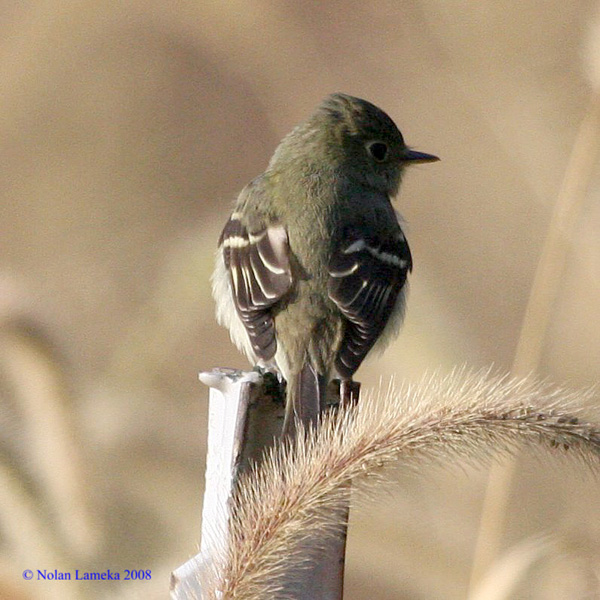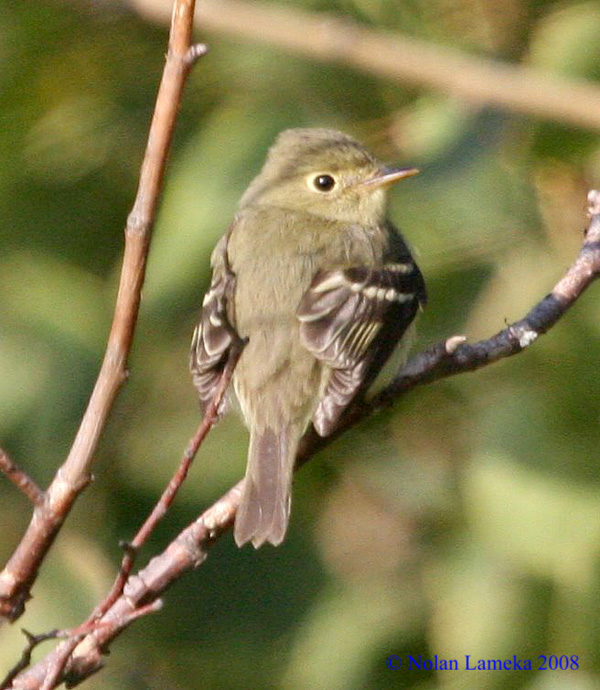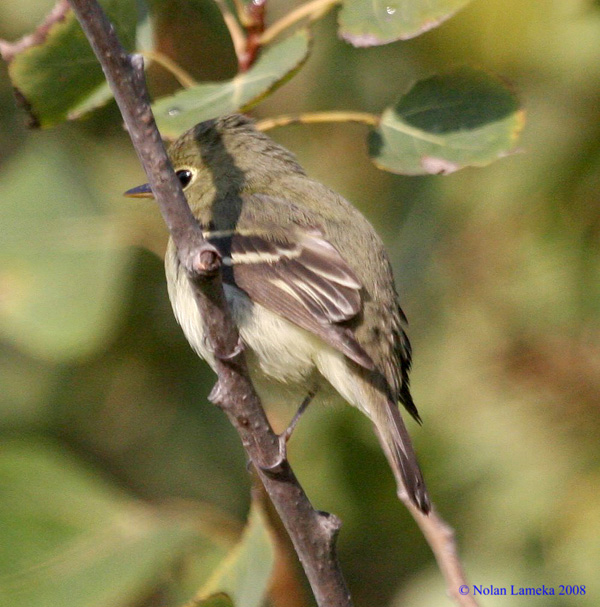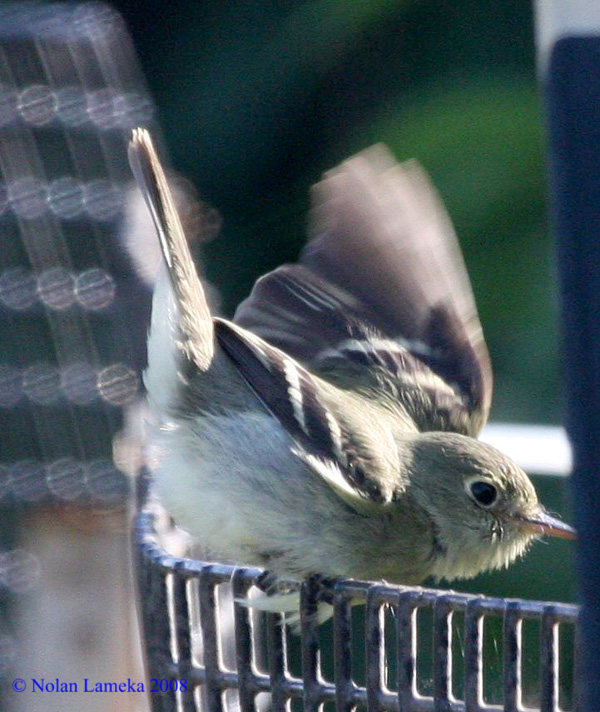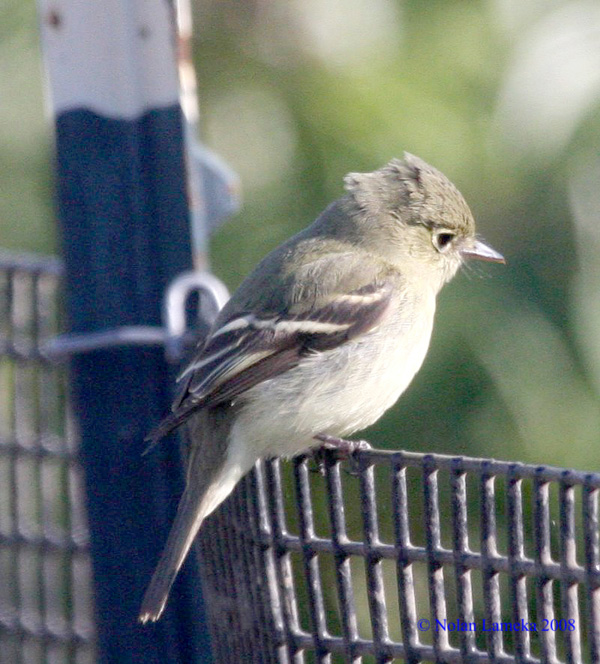Yellow-bellied Flycatcher
|
|
Date
|
County
(tier)
|
Observer
|
|
21-23
Nov 2004
|
Cook
(north)
|
Paul
Clyne, Doug Stotz, Tom Schulenburg
|
|
13
Nov 1980
|
Sangamon
(central)
|
Dave
Bohlen
|
|
13
Oct 1975
|
Sangamon
(central)
|
Dave
Bohlen
|
|
9
Oct 1984
|
Sangamon
(central)
|
Dave
Bohlen
|
|
7
Oct 1990
|
Sangamon
(central)
|
Dave
Bohlen
|
|
3
Oct 1987
|
Sangamon
(central)
|
Dave
Bohlen
|
|
2
Oct 1987
|
Cook
(north)
|
Harriet
Rylaarsdam
|
|
2
Oct 2000
|
Putnam
(north)
|
Doug
Stotz
|
|
2
Oct 2003
|
Kankakee
(central)
|
Jed
Hertz
|
Paul Clyne graciously provided me with information about the record from Fall 1990 (added to the above table on 20 Oct 2008). I didn't have the relevant journal that covered that season (Illinois Birds & Birding, vol. 7 no. 2), but apparently Paul carries it with him while traveling and was able to supply me the datum from Macedonia.
Neither Cordilleran Flycatcher nor Pacific-slope Flycatcher has been recorded in Illinois.
Addtional remarks posted here 19 Dec 2008:
A couple of folks have remarked to me that it seems odd to have a Yellow-bellied Flycatcher being out in the open so much. I was bothered by this behavior, too, and at the time of the sighting. When I was looking at the bird as it perched on the fence post shown in the first couple of photos, I thought it was a really odd perch for a Yellow-bellied, but at the same time I was rather happy. It just sat there and I told Nolan to get a photo of that bird (figuring, well, since it was an empid in mid-October a photo could be handy). I rationalized my concerns about behavior away somewhat because the bird was on the outer edge of a particular grove of trees on the interior of which I have often seen Yellow-bellied Flycatchers. At this initial sighting on Saturday, we lost sight of the bird when it went inside this grove. But then on Sunday it merrily sat outside another grove of trees ..... Hmm.
Desante et al. (1985) discuss the separation of Yellow-bellied Flycatcher from Western Flycatcher on the basis of primary and tail feather lengths in the case of first-year females. However, this approach is probably not useful here because the sex of the bird isn't known, the age remains somewhat uncertain, and estimates of feather lengths from the photos may not be accurate enough.
A Western Flycatcher was found in Connecticut in fall of 2007. Here is a link to Mark Szantyr's photos this bird on 1 Dec 2007: http://birddog55.zenfolio.com/p55257368. Another photo of this bird is at the Connecticut Ornithological Association's webpage (scroll down to the bottom of the rare bird photos).
Seven individuals responded to my request for input on this bird in a post to the Frontiers of Field Identificaiton listserve. Here is a brief summary of comments provided.
|
As might be expected, no one was willing to make a definitive call as to specific identification. A couple of respondents from western North America felt that the bird would be readily taken as a Western-type if seen in its normal range. Some points raised as going against Yellow-bellied were
On the issue of the birds age, responses were mixed. Four remarked explicitly on the age: two stated they felt it was an adult bird (one of these mentioning worn wing feathers), one indicated it's a young bird (on the basis of pointed rectrices), and one saw mixed evidence. This latter individual thought that though the retrix shape seems to indicate an adult, "based on the apparent condition of primaries, secondaries, and coverts, it looks more like a hatch-year bird. The edging on the secondaries and on the tips of the primaries still looks pretty fresh to me. And the tips of the greater & median coverts - the wingbars - just look too fresh & too broad to me to be 9-10 months old." |
Addtional remarks posted here 2 Jan 2009:
Peter Pyle pointed me to his article with Matt Heindel (Heindel and Pyle, 1999). Information in this paper, especially regarding the wing formulae but also in regard to some other features, would seem to indicate that the Montrose Point bird is a Yellow-bellied Flycatcher. I will post more details about this when I have a chance to.
Addtional remarks posted here 17 Mar 2015:
Spurred by the publication of the work by Baumann et al. (2014), here is an update.
My review of Heindel and Pyle (1999) prompted a focus on the spacing of the primary gaps. That work noted that "The distance between p7 and p6 is longer in Yellow-bellied than in Western flycatcher, whereas the distances bewteen p6 and p6 and between p5 and p4 are similar but average larger in Western Flycatchers." On 7 Aug 2009, I visited the Field Museum of Natural History and measured primary spacings on 31 Pacific-slope Flycatcher, 21 Cordilleran Flycatcher, and 60 Yellow-bellied Flycatcher study skins. The measurements revealed that the ratio of the gap between p6 and p5 to the gap between p7 and p6 can help separate between Yellow-bellied and Pacific-slope/Cordilleran Flycatchers. If this ratio is two or greater, it's almost surely a Pacific-slope/Cordillaran, while a ratio of 1.5 or less means Yellow-bellied. Assessing this ratio from the photographs of the Montrose Point bird yielded ratios from 0.95 to 1.55, providing evidence in support of identification as a Yellow-bellied Flycatcher.
A couple years later, a 6 Nov 2011 post to ID-Frontiers by Tony Leukering and the subequent response by Joe Morlan brought to my attention another feature that would help: the extent of a dark bar between the edges of the secondary fringes and the lower wing bar, wider in Yellow-bellied than in Pacific-slope/Cordilleran. This feature on the Montrose Point bird again suggested Yellow-bellied, but at the time of these posts this field mark had not been quantified. The paper by Baumann et al. (2014) addressed this shortcoming, and at the same time exposed Illinois's first record of Pacific-slope/Cordilleran Flycatcher, which had been deposited in the Field Museum as a Yellow-bellied Flycatcher after having met its end in a collision with a McCormick Place window.
References
M.J. Baumann, S.C. Galen, N.D. Pederson, and C.C. Will, "Simple Technique for Distinguishing Yellow-bellied Flycatchers from Cordilleran and Pacific-slope Flycatchers," Journal of Field Ornithology, vol. 85, no. 4, pp. 391-396, 2014.
D.F. DeSante, N.K. Johnson, R. LeValley, R.P. Henderson, "Occurrence and Identification of the Yellow-bellied Flycatcher on Southeast Farallon Island, California," Western Birds, vol. 16, no. 4, pp. 153-160, 1985.
Gross, Douglas A. and Peter E. Lowther. 2001. Yellow-bellied Flycatcher (Empidonax flaviventris), The Birds of North America Online (A. Poole, Ed.). Ithaca: Cornell Lab of Ornithology; Retrieved from the Birds of North America Online: http://bna.birds.cornell.edu/bna/species/566
M. Heindel and P. Pyle, "Identification of Yellow-bellied and 'Western' Flycatchers," Birders Journal, vol. 8, no. 2, pp. 78-87, 1999.
Lowther, Peter E. 2000a. Pacific-slope Flycatcher (Empidonax difficilis), The Birds of North America Online (A. Poole, Ed.). Ithaca: Cornell Lab of Ornithology; Retrieved from the Birds of North America Online: http://bna.birds.cornell.edu/bna/species/556a
Lowther, Peter E. 2000b. Cordilleran Flycatcher (Empidonax occidentalis), The Birds of North America Online (A. Poole, Ed.). Ithaca: Cornell Lab of Ornithology; Retrieved from the Birds of North America Online: http://bna.birds.cornell.edu/bna/species/556b
P. Pyle, S.N.G. Howell, R.P. Yunick, D.F. DeSante, Identification Guide to North American Passerines. Bolinas, CA: Slate Creek Press, 1987.
B. Whitney and K. Kaufman, "The Empidonax Challenge, Part IV," Birding, vol. 18, no. 6, pp. 315 - 327, December 1986.
This
page was last updated on 17 March 2015.
Contact Geoff Williamson
with any comments, updates or suggestions.
